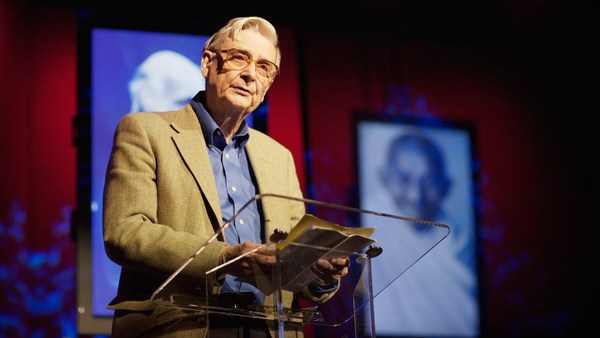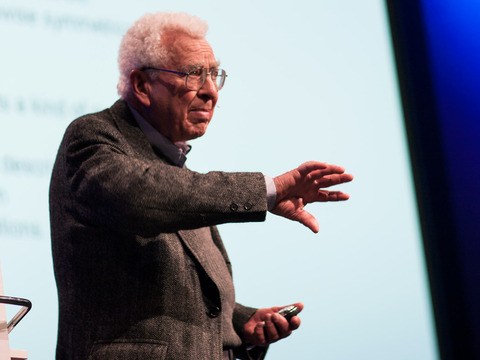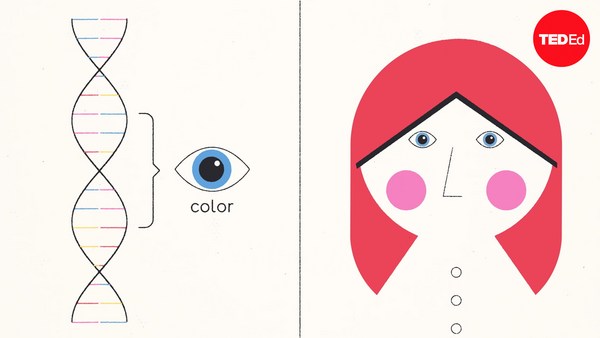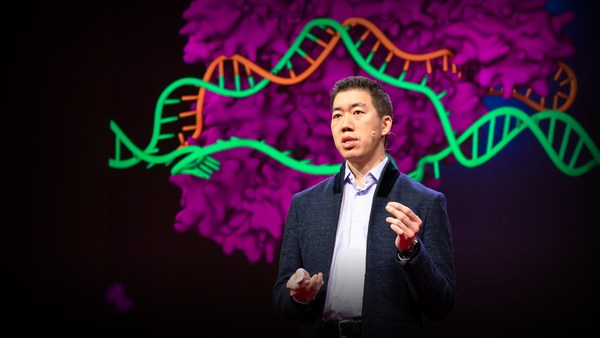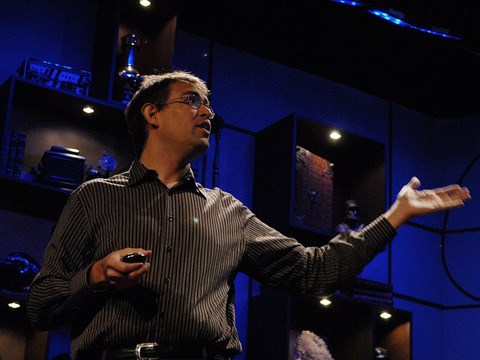Well, I thought there would be a podium, so I'm a bit scared. (Laughter) Chris asked me to tell again how we found the structure of DNA. And since, you know, I follow his orders, I'll do it. But it slightly bores me. (Laughter) And, you know, I wrote a book. So I'll say something -- (Laughter) -- I'll say a little about, you know, how the discovery was made, and why Francis and I found it. And then, I hope maybe I have at least five minutes to say what makes me tick now.
In back of me is a picture of me when I was 17. I was at the University of Chicago, in my third year, and I was in my third year because the University of Chicago let you in after two years of high school. So you -- it was fun to get away from high school -- (Laughter) -- because I was very small, and I was no good in sports, or anything like that.
But I should say that my background -- my father was, you know, raised to be an Episcopalian and Republican, but after one year of college, he became an atheist and a Democrat. (Laughter) And my mother was Irish Catholic, and -- but she didn't take religion too seriously. And by the age of 11, I was no longer going to Sunday Mass, and going on birdwatching walks with my father. So early on, I heard of Charles Darwin. I guess, you know, he was the big hero. And, you know, you understand life as it now exists through evolution.
And at the University of Chicago I was a zoology major, and thought I would end up, you know, if I was bright enough, maybe getting a Ph.D. from Cornell in ornithology. Then, in the Chicago paper, there was a review of a book called "What is Life?" by the great physicist, Schrodinger. And that, of course, had been a question I wanted to know. You know, Darwin explained life after it got started, but what was the essence of life?
And Schrodinger said the essence was information present in our chromosomes, and it had to be present on a molecule. I'd never really thought of molecules before. You know chromosomes, but this was a molecule, and somehow all the information was probably present in some digital form. And there was the big question of, how did you copy the information?
So that was the book. And so, from that moment on, I wanted to be a geneticist -- understand the gene and, through that, understand life. So I had, you know, a hero at a distance. It wasn't a baseball player; it was Linus Pauling. And so I applied to Caltech and they turned me down. (Laughter) So I went to Indiana, which was actually as good as Caltech in genetics, and besides, they had a really good basketball team. (Laughter) So I had a really quite happy life at Indiana. And it was at Indiana I got the impression that, you know, the gene was likely to be DNA. And so when I got my Ph.D., I should go and search for DNA.
So I first went to Copenhagen because I thought, well, maybe I could become a biochemist, but I discovered biochemistry was very boring. It wasn't going anywhere toward, you know, saying what the gene was; it was just nuclear science. And oh, that's the book, little book. You can read it in about two hours. And -- but then I went to a meeting in Italy. And there was an unexpected speaker who wasn't on the program, and he talked about DNA. And this was Maurice Wilkins. He was trained as a physicist, and after the war he wanted to do biophysics, and he picked DNA because DNA had been determined at the Rockefeller Institute to possibly be the genetic molecules on the chromosomes. Most people believed it was proteins. But Wilkins, you know, thought DNA was the best bet, and he showed this x-ray photograph. Sort of crystalline. So DNA had a structure, even though it owed it to probably different molecules carrying different sets of instructions. So there was something universal about the DNA molecule. So I wanted to work with him, but he didn't want a former birdwatcher, and I ended up in Cambridge, England.
So I went to Cambridge, because it was really the best place in the world then for x-ray crystallography. And x-ray crystallography is now a subject in, you know, chemistry departments. I mean, in those days it was the domain of the physicists. So the best place for x-ray crystallography was at the Cavendish Laboratory at Cambridge. And there I met Francis Crick. I went there without knowing him. He was 35. I was 23. And within a day, we had decided that maybe we could take a shortcut to finding the structure of DNA. Not solve it like, you know, in rigorous fashion, but build a model, an electro-model, using some coordinates of, you know, length, all that sort of stuff from x-ray photographs. But just ask what the molecule -- how should it fold up?
And the reason for doing so, at the center of this photograph, is Linus Pauling. About six months before, he proposed the alpha helical structure for proteins. And in doing so, he banished the man out on the right, Sir Lawrence Bragg, who was the Cavendish professor. This is a photograph several years later, when Bragg had cause to smile. He certainly wasn't smiling when I got there, because he was somewhat humiliated by Pauling getting the alpha helix, and the Cambridge people failing because they weren't chemists. And certainly, neither Crick or I were chemists, so we tried to build a model. And he knew, Francis knew Wilkins. So Wilkins said he thought it was the helix. X-ray diagram, he thought was comparable with the helix.
So we built a three-stranded model. The people from London came up. Wilkins and this collaborator, or possible collaborator, Rosalind Franklin, came up and sort of laughed at our model. They said it was lousy, and it was. So we were told to build no more models; we were incompetent. (Laughter) And so we didn't build any models, and Francis sort of continued to work on proteins. And basically, I did nothing. And -- except read. You know, basically, reading is a good thing; you get facts. And we kept telling the people in London that Linus Pauling's going to move on to DNA. If DNA is that important, Linus will know it. He'll build a model, and then we're going to be scooped.
And, in fact, he'd written the people in London: Could he see their x-ray photograph? And they had the wisdom to say "no." So he didn't have it. But there was ones in the literature. Actually, Linus didn't look at them that carefully. But about, oh, 15 months after I got to Cambridge, a rumor began to appear from Linus Pauling's son, who was in Cambridge, that his father was now working on DNA. And so, one day Peter came in and he said he was Peter Pauling, and he gave me a copy of his father's manuscripts. And boy, I was scared because I thought, you know, we may be scooped. I have nothing to do, no qualifications for anything. (Laughter)
And so there was the paper, and he proposed a three-stranded structure. And I read it, and it was just -- it was crap. (Laughter) So this was, you know, unexpected from the world's -- (Laughter) -- and so, it was held together by hydrogen bonds between phosphate groups. Well, if the peak pH that cells have is around seven, those hydrogen bonds couldn't exist. We rushed over to the chemistry department and said, "Could Pauling be right?" And Alex Hust said, "No." So we were happy. (Laughter)
And, you know, we were still in the game, but we were frightened that somebody at Caltech would tell Linus that he was wrong. And so Bragg said, "Build models." And a month after we got the Pauling manuscript -- I should say I took the manuscript to London, and showed the people. Well, I said, Linus was wrong and that we're still in the game and that they should immediately start building models. But Wilkins said "no." Rosalind Franklin was leaving in about two months, and after she left he would start building models. And so I came back with that news to Cambridge, and Bragg said, "Build models." Well, of course, I wanted to build models. And there's a picture of Rosalind. She really, you know, in one sense she was a chemist, but really she would have been trained -- she didn't know any organic chemistry or quantum chemistry. She was a crystallographer.
And I think part of the reason she didn't want to build models was, she wasn't a chemist, whereas Pauling was a chemist. And so Crick and I, you know, started building models, and I'd learned a little chemistry, but not enough. Well, we got the answer on the 28th February '53. And it was because of a rule, which, to me, is a very good rule: Never be the brightest person in a room, and we weren't. We weren't the best chemists in the room. I went in and showed them a pairing I'd done, and Jerry Donohue -- he was a chemist -- he said, it's wrong. You've got -- the hydrogen atoms are in the wrong place. I just put them down like they were in the books. He said they were wrong.
So the next day, you know, after I thought, "Well, he might be right." So I changed the locations, and then we found the base pairing, and Francis immediately said the chains run in absolute directions. And we knew we were right. So it was a pretty, you know, it all happened in about two hours. From nothing to thing. And we knew it was big because, you know, if you just put A next to T and G next to C, you have a copying mechanism. So we saw how genetic information is carried. It's the order of the four bases. So in a sense, it is a sort of digital-type information. And you copy it by going from strand-separating. So, you know, if it didn't work this way, you might as well believe it, because you didn't have any other scheme. (Laughter)
But that's not the way most scientists think. Most scientists are really rather dull. They said, we won't think about it until we know it's right. But, you know, we thought, well, it's at least 95 percent right or 99 percent right. So think about it. The next five years, there were essentially something like five references to our work in "Nature" -- none. And so we were left by ourselves, and trying to do the last part of the trio: how do you -- what does this genetic information do? It was pretty obvious that it provided the information to an RNA molecule, and then how do you go from RNA to protein? For about three years we just -- I tried to solve the structure of RNA. It didn't yield. It didn't give good x-ray photographs. I was decidedly unhappy; a girl didn't marry me. It was really, you know, sort of a shitty time. (Laughter)
So there's a picture of Francis and I before I met the girl, so I'm still looking happy. (Laughter) But there is what we did when we didn't know where to go forward: we formed a club and called it the RNA Tie Club. George Gamow, also a great physicist, he designed the tie. He was one of the members. The question was: How do you go from a four-letter code to the 20-letter code of proteins? Feynman was a member, and Teller, and friends of Gamow. But that's the only -- no, we were only photographed twice. And on both occasions, you know, one of us was missing the tie. There's Francis up on the upper right, and Alex Rich -- the M.D.-turned-crystallographer -- is next to me. This was taken in Cambridge in September of 1955. And I'm smiling, sort of forced, I think, because the girl I had, boy, she was gone. (Laughter)
And so I didn't really get happy until 1960, because then we found out, basically, you know, that there are three forms of RNA. And we knew, basically, DNA provides the information for RNA. RNA provides the information for protein. And that let Marshall Nirenberg, you know, take RNA -- synthetic RNA -- put it in a system making protein. He made polyphenylalanine, polyphenylalanine. So that's the first cracking of the genetic code, and it was all over by 1966. So there, that's what Chris wanted me to do, it was -- so what happened since then? Well, at that time -- I should go back. When we found the structure of DNA, I gave my first talk at Cold Spring Harbor. The physicist, Leo Szilard, he looked at me and said, "Are you going to patent this?" And -- but he knew patent law, and that we couldn't patent it, because you couldn't. No use for it. (Laughter)
And so DNA didn't become a useful molecule, and the lawyers didn't enter into the equation until 1973, 20 years later, when Boyer and Cohen in San Francisco and Stanford came up with their method of recombinant DNA, and Stanford patented it and made a lot of money. At least they patented something which, you know, could do useful things. And then, they learned how to read the letters for the code. And, boom, we've, you know, had a biotech industry. And, but we were still a long ways from, you know, answering a question which sort of dominated my childhood, which is: How do you nature-nurture?
And so I'll go on. I'm already out of time, but this is Michael Wigler, a very, very clever mathematician turned physicist. And he developed a technique which essentially will let us look at sample DNA and, eventually, a million spots along it. There's a chip there, a conventional one. Then there's one made by a photolithography by a company in Madison called NimbleGen, which is way ahead of Affymetrix. And we use their technique. And what you can do is sort of compare DNA of normal segs versus cancer. And you can see on the top that cancers which are bad show insertions or deletions. So the DNA is really badly mucked up, whereas if you have a chance of surviving, the DNA isn't so mucked up. So we think that this will eventually lead to what we call "DNA biopsies." Before you get treated for cancer, you should really look at this technique, and get a feeling of the face of the enemy. It's not a -- it's only a partial look, but it's a -- I think it's going to be very, very useful.
So, we started with breast cancer because there's lots of money for it, no government money. And now I have a sort of vested interest: I want to do it for prostate cancer. So, you know, you aren't treated if it's not dangerous. But Wigler, besides looking at cancer cells, looked at normal cells, and made a really sort of surprising observation. Which is, all of us have about 10 places in our genome where we've lost a gene or gained another one. So we're sort of all imperfect. And the question is well, if we're around here, you know, these little losses or gains might not be too bad. But if these deletions or amplifications occurred in the wrong gene, maybe we'll feel sick.
So the first disease he looked at is autism. And the reason we looked at autism is we had the money to do it. Looking at an individual is about 3,000 dollars. And the parent of a child with Asperger's disease, the high-intelligence autism, had sent his thing to a conventional company; they didn't do it. Couldn't do it by conventional genetics, but just scanning it we began to find genes for autism. And you can see here, there are a lot of them. So a lot of autistic kids are autistic because they just lost a big piece of DNA. I mean, big piece at the molecular level. We saw one autistic kid, about five million bases just missing from one of his chromosomes. We haven't yet looked at the parents, but the parents probably don't have that loss, or they wouldn't be parents. Now, so, our autism study is just beginning. We got three million dollars. I think it will cost at least 10 to 20 before you'd be in a position to help parents who've had an autistic child, or think they may have an autistic child, and can we spot the difference? So this same technique should probably look at all. It's a wonderful way to find genes.
And so, I'll conclude by saying we've looked at 20 people with schizophrenia. And we thought we'd probably have to look at several hundred before we got the picture. But as you can see, there's seven out of 20 had a change which was very high. And yet, in the controls there were three. So what's the meaning of the controls? Were they crazy also, and we didn't know it? Or, you know, were they normal? I would guess they're normal. And what we think in schizophrenia is there are genes of predisposure, and whether this is one that predisposes -- and then there's only a sub-segment of the population that's capable of being schizophrenic.
Now, we don't have really any evidence of it, but I think, to give you a hypothesis, the best guess is that if you're left-handed, you're prone to schizophrenia. 30 percent of schizophrenic people are left-handed, and schizophrenia has a very funny genetics, which means 60 percent of the people are genetically left-handed, but only half of it showed. I don't have the time to say. Now, some people who think they're right-handed are genetically left-handed. OK. I'm just saying that, if you think, oh, I don't carry a left-handed gene so therefore my, you know, children won't be at risk of schizophrenia. You might. OK? (Laughter)
So it's, to me, an extraordinarily exciting time. We ought to be able to find the gene for bipolar; there's a relationship. And if I had enough money, we'd find them all this year. I thank you.
